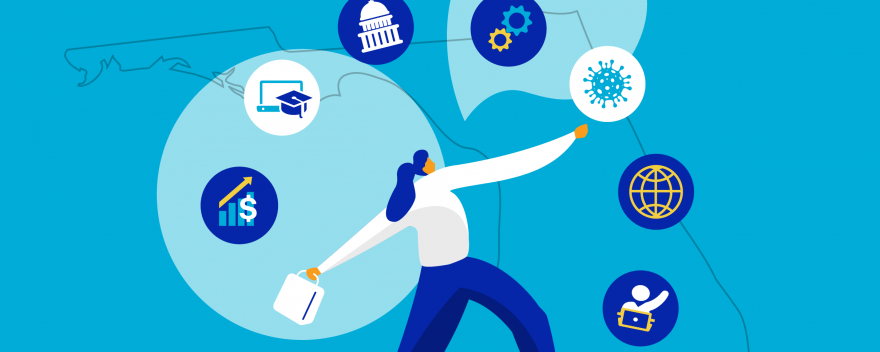Inside the Florida K-12 Market: District Priorities and Pain Points

Many states have taken a cautious approach to reopening schools for in-person instruction during the pandemic. Florida was much more ambitious.
The vast majority of school districts across the nation’s third most populous state were required by the state’s department of education to offer an in-person learning option at the beginning of the academic year. That meant the state’s 67 main, county-based districts were tasked with finding a way to serve not only families who wanted face-to-face instruction, but also those who chose online instruction at home.
As such, Florida’s experiences offer a preview of what an increasing number of school districts around the country are now going through, as they transition into more fully in-person and hybrid instructional models. A new special report, available exclusively to EdWeek Market Brief members, provides education companies and other organizations keen on working in Florida with an in-depth look at the biggest needs that the state’s 67 school districts face, as they continue to straddle the brick-and-mortar and online learning worlds.
Through our reporting and analysis, readers will learn about Florida school systems’ hunger for academic interventions and other strategies to address learning loss, and their need to bolster the well-being of students whose emotional states have been made fragile by the upheaval of COVID-19.
Readers will get districts’ perspectives on the massive scale of their device purchasing over the past year, and prevailing worries about lackluster internet connectivity in students’ homes. And they will learn about the pressure Florida districts face to implement new state academic standards — and to scaffold myriad instructional materials, assessments, and professional development for teachers on top of those standards.
This special report is the final installment in a three-part series on state markets that have enormous importance for companies in the K-12 market. The first two reports focused on Texas and California. This report, like the others, includes original research drawn from surveys of Florida K-12 officials. But the heart of the analysis is interviews EdWeek Market Brief’s editorial team conducted with key district administrators, including superintendents and their top deputies, curriculum directors, finance officials, and others.
Student Engagement, Standards, and Remediation
The Florida report includes perspectives of district officials like Robert Bixler, the associate superintendent for curriculum and digital learning in the Orange County school system, based in Orlando.
Bixler explains how his district began turning its attention to students’ anticipated learning loss as early as last summer, offering targeted academic programs and focusing on students thought to be most vulnerable, particularly in elementary grades.
Since then, the 212,000-student district has been exploring strategies for remediation that can be delivered in a variety of in-person and online settings.
“You are always concerned about the kids who are most at risk and what they’re missing in school,” Bixler said. “We’re all trying to find ways to meet their needs–with intervention, tutoring, all those things.”
Among the other insights offered in the report:
- Survey data collected from Florida K-12 officials about their top academic priorities over the next year – which include both instructional and non-academic needs.
- Perspective on the key factors that will drive Florida district officials’ decisions on selection and purchasing of curriculum and other academic resources to align with new state academic standards.
- Details on the current blend of in-person vs. remote instruction in Florida districts, and their plans for offering summer instruction focused on learning loss.
- The results of in-depth interviews with district officials from across the state about their biggest needs from vendors, the state policies shaping their work, how they plan to spend federal funding.
Another major school system highlighted in the report, the Palm Beach County district, is – like many in Florida — trying to navigate two different worlds, with about 50 percent of its students taking classes in person, and remainder working remotely.
Teachers have found “unbelievable and inspiring” ways to help students and encourage them to think creatively in online settings, particularly through technology, said Deputy Superintendent and Chief of Schools Keith Oswald.
But the 193,000-student district needs more innovation and flexibility from education companies, to keep students locked in no matter what their learning environment.
“Engagement has been our number-one priority,” he said. Every day the district looks for “little things that can enhance how [tech] is used in this environment,” and vendors who can “enhance what students do in a distance learning space.”
EdWeek Market Brief members can access the report here.
Image by Getty
See also:
- Inside the Texas K-12 Market: District Priorities and Pain Points
- Inside the California K-12 Market: District Priorities and Pain Points
